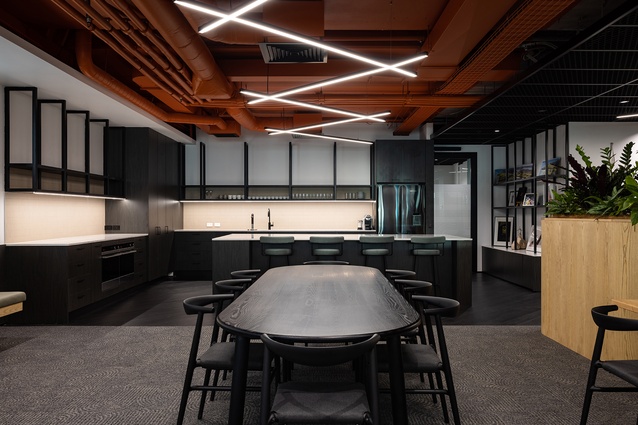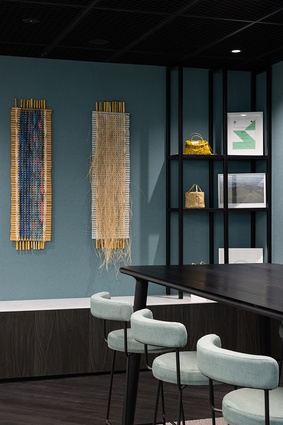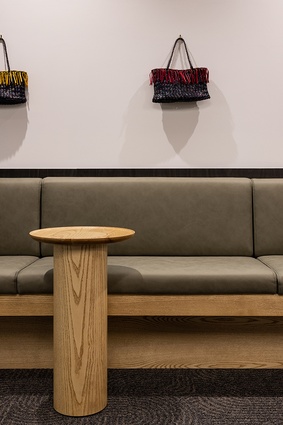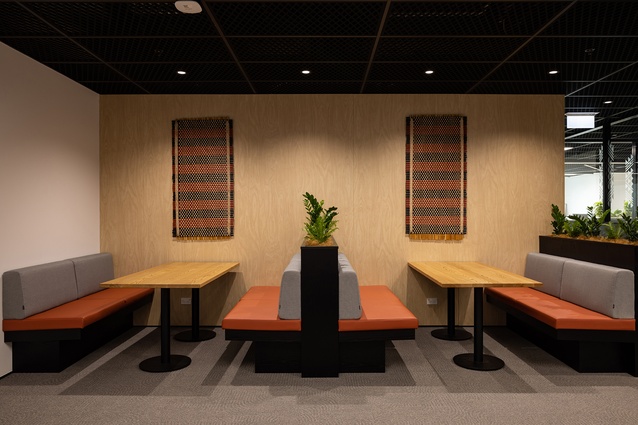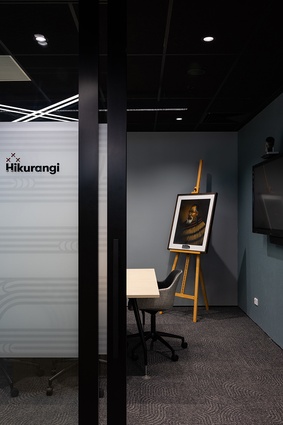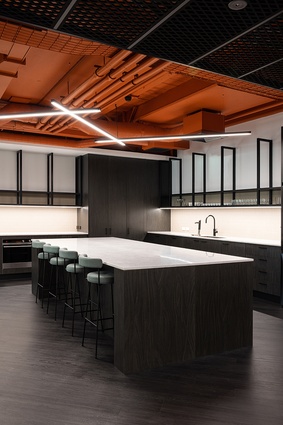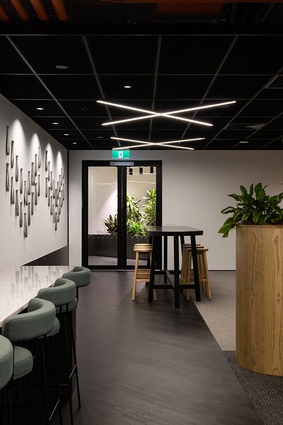Expressing Māori kaupapa within a workplace interior
Waipapa Taumata Rau University of Auckland teaching fellow Amber Ruckes (Tūhoe, African American) visits Ngāti Whātua Ōrākei’s new workspace in Te Tōangaroa — a collaboration between the hapū and Stack Interiors — and finds it has been designed with whānaungatanga at its essence.
Te Kahu Tōpuni o Tuperiri (the outstretched cloak of Tuperiri) is a figurative term used to describe the tribal territories of Ngāti Whātua within the Tāmaki Makaurau Auckland region. Ngāti Whātua occupation of Tāmaki Makaurau began in the 17th century, under the leadership of Tuperiri. In 1840, Tuperiri’s grandson Āpihai Te Kawau and six other chiefs invited Governor Hobson to come and live with them. This invitation led to Tāmaki Makaurau becoming the capital of Aotearoa until 1865. Ngāti Whātua Ōrākei is one of the hapū from the wider Ngāti Whātua iwi who trace their whakapapa back to Tuperiri.
Today, Ngāti Whātua Ōrākei affairs are conducted by the Ngāti Whātua Ōrākei Trust and its subsidiaries Whai Māia (social arm) and Whai Rawa (commercial arm). Originally, the Trust did not require a large office space but both the Trust and Whai Rawa have grown in capacity and capability with the work that they do for the Ngāti Whātua Ōrākei whānau. So, when the lease of the previous Whai Rawa office ended, it made sense for both organisations to come together.
The site of the new workspace is in Te Tōangaroa Quay Park. This area was once a hive for trade. Along with Ngāti Whātua, iwi as far away as Ngāti Porou (East Cape and Gisborne) and Ngāti Maniapoto (Waikato) would park their waka along the shoreline (now Beach Road) and set up their stalls to sell produce and other commodities to settlers. Today, Te Tōangaroa is Ngāti Whātua Ōrākei’s single largest commercial asset; providing important income for the hapū to re-invest. This location re-establishes the presence of Ngāti Whātua Ōrākei within Tāmaki Makaurau’s central business district.
In a nod to the entrepreneurial spirit of Te Tōangaroa, the new workplace for the Trust and Whai Rawa celebrates a design process which values collaboration, integration and utilisation, while also exploring what whānaungatanga (strengthening ties between kin and communities) could be within a commercial environment.
Designed by commercial interior design studio Stack Interiors, the brief called for a functional and agile workplace that recognised the needs of both groups. The other challenge that Stack faced was to create a space that reflected who Ngāti Whātua Ōrākei are now as well as who they could be in the future. Located at Tōangaroa in the AECOM House, there is also the question: How can a Māori kaupapa be expressed and thrive in a manner that speaks to the whānau it serves within the context of an existing floorplate?
Stepping out of the lift, there are two possible entries, both of which set up a type of spine within the floorplan that spans between them. Both entries opt for a soft reception approach. Entering from the Whai Rawa side, you are greeted with an informal collaboration space that neighbours Hikurangi, the Whai Rawa boardroom.
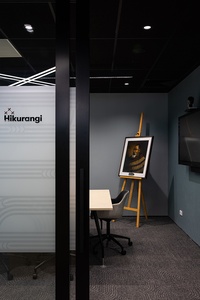
Each name within this scheme has its own whakapapa (connections to people and our relationship with these people). Hikurangi, for example, pays tribute to the pā of the same name that was established by Ngāti Whātua chief Tuperiri at Maungakiekie One Tree Hill. In Hikurangi, you are introduced to unaunahi (fish scale) illustrations that act as a part of the manifestations along the window glazing. Unaunahi acknowledges the foreshore history of the area. Coming out of Hikurangi, you enjoy a view of a tukutuku artwork composed of fiberglass panels and flax.
A full-height shelving unit acts as a spatial buffer which separates the soft reception from the Whai Rawa open-plan workspace. One of many integrated shelving systems throughout this space, these units act as galleries to display creative works by Ngāti Whātua Ōrākei whānau as well as other taonga. Items such as a traditional hue (water bottle), a patu belonging to Dave Harriman (Ngāti Whātua curator), a bedazzled kete and a Green Star Award bestowed on the hapū are just some of the taonga showcasing the creative diversity within Ngāti Whātua Ōrākei.
Once in the Whai Rawa workspace, you are entering the floorplan spine. The space Stack had to work with was relatively narrow but does not feel uncomfortable. Walking through the Whai Rawa workspace towards the kihini (kitchen), and to your left, you pass meeting spaces Te Pou, Te Aka, and Te Tumu. These three rooms represent qualities of progression, whakapapa, generational collaboration and whenua (a physical and spiritual connection to the land). Prior to entering the kihini from this end you also encounter a larger collaboration space with built-in soft furnishings and another gallery nook that softens the undeviating floorplan. There you encounter a niho taniwha design along the glazing that can also be found on kapa haka uniforms from within the hapū.
The Ngāti Whātua Ōrākei Trust entry takes a slightly different approach to its soft reception with a series of built-in booths. Above the booths are more traditional tukutuku works that play on their contemporary counterparts at the other entry. The success of this dual entry approach is that it allows for everyday work and formal ceremonies to happen simultaneously when required. To the left of the booths, towards the open plan workspace of the Trust are Hikuroa (Trust Boardroom), Te Kāhu (CEO office), and Te Hau (corner office). These three rooms represent the people, their leadership, their world and their home.
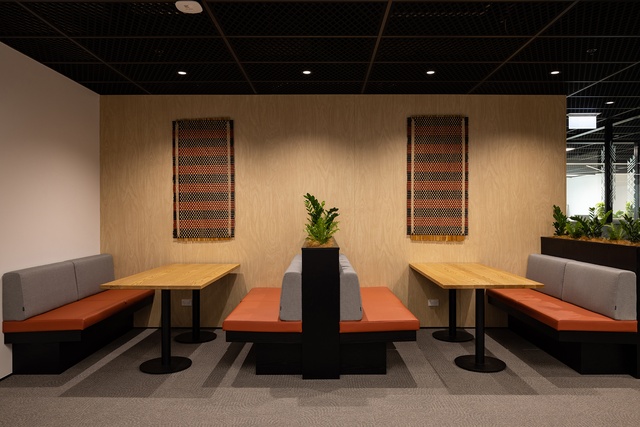
Directly ahead of the Trust entry is the kihini, the placement and scale of which creates an interesting shift when reflecting on more familiar workplace typologies. Kai (food) has many roles within Te Ao Māori, one of which is the ability to remove restrictions. The centralisation of the kihini bridges the Trust and the Whai Rawa organisation; reaffirming that the restrictions of being in two separate locations has passed.
With all the built-in seating, tables and chairs, there is no doubt that this kihini can accommodate at least 30 people. Black kete with speckles of yellow and maroon adorn the wall. Tamariki holiday programmes are also hosted here, giving precedence to future generations to come.
The ceiling of the kihini also has its own story. Painted Ahikāroa (a bold orange), it alludes to the sunrise and sunset at Takaparawhau (Bastion Point), solidifying notions of Ahi Kā (being the people at home). Ahikāroa is one of many bespoke colours stemming from the Ko ngā tae i tāmokongia ki te Kahu Tōpuni o Tuperiri palette, which was the result of collaboration between Ngāti Whātua Ōrākei, their whānau and Resene.

Qualities of whānaungatanga are present in the planning through the kihini, which bridges the Trust and Whai Rawa spaces while also hosting whānau. The personalised touches through the display of taonga also play an important role in connecting the community to this space.
I was privileged to be shown around this space by people with knowledge on the kaupapa around design elements and taonga; and both the Trust and Whai Rawa are very happy with what it represents. The scope of collaboration goes beyond Ngāti Whātua Ōrākei and Stack, as it includes the involvement of whānau. It is whānau who cement the relationship and give the workspace life. Ngā mihi nui kia koutou katoa.

